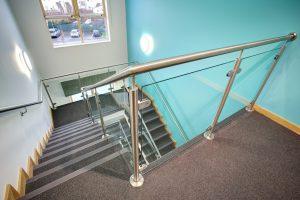ARE CLIP FIXINGS REALLY WORTH THE RISK?
Posted on 28th January 2016For principal contractors and developers, speed of installation is often a vital consideration when assessing whether a balustrade system is right for a scheme, because it determines whether it will help the project remain on programme.
For the specifier, however, end user safety is business critical when selecting a balustrade supplier or an individual system. And, when it comes to long term durability and safety – quality counts and due diligence on compliance is vital.
Regardless of how great a balustrade may look or how durable it may seem, unless it is compliant, the specifier cannot be certain that it is safe so it’s always essential for the specifier to follow the relevant British Standards guidance to the letter and seek the technical support and advice of the balustrade supplier.
A common example of poor compliance that often leads to unsafe balustrade installations is the frequent use of clip glass fixings or ‘clamp lugs’, which rely on ‘pinching’ the edges of the panels, without any mechanical fixing through a pre-drilled hole in the panel.
While BS6180 does make provision for the use of clip glass fixings in balustrade installations, hence their widespread use, it is very specific in its guidance for their use in terms of spacing, clip size and minimum depth. If the fixings are not used as stipulated in the standard, the system is not compliant, which also means that it is potentially unsafe.
Indeed, we have been alerted to a number of instances where glass infill panels have slipped under their own weight as a result of this very issue, which why is all Delta Balustrades systems only use bolt-though glass lugs, which never carry any risk of slipping or falling. All our systems are CE marked and fully compliant to BS6180 and BS EN 1090-1.
Compliance may seem like onerous box ticking to some but standards are compiled and revised for a good reason and are there to underpin safety. So it’s never advisable to assume that a system is compliant – responsibility for compliance to regulations lies with the architect, so it’s worth double-checking that the specification meets the standard.

